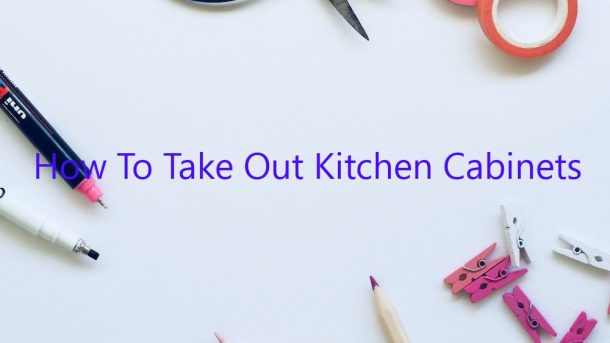How To Take Out Kitchen Cabinets
If you are wanting to remodel your kitchen, or just need to get to that faulty appliance lurking behind your cabinets, you’ll need to know how to take out kitchen cabinets. Kitchen cabinets are typically held in place by screws or nails located on the inside of the cabinet. By following a few simple steps, you can have them out in no time.
To take out kitchen cabinets, you will first need to remove the doors. This can be done by unscrewing the hinges or by prying them off with a screwdriver. Once the doors are off, you can remove the screws or nails that hold the cabinet in place. Be careful not to damage the wall when doing this. Once the cabinet is free, you can pull it out and set it aside.
Repeat these steps for each cabinet that needs to be removed. If you are unsure of how to take out kitchen cabinets, or if they are too heavy for you to remove on your own, it is best to call in a professional.
Contents
- 1 Can I remove kitchen cabinets myself?
- 2 How do you remove cabinets without damaging drywall?
- 3 How do you remove kitchen base cabinets?
- 4 How do you remove kitchen cabinets without damaging them?
- 5 How long does it take to remove kitchen cabinets?
- 6 How are kitchen cabinets attached to the floor?
- 7 How are kitchen cabinets attached to the wall?
Can I remove kitchen cabinets myself?
Removing kitchen cabinets can seem like a daunting task, but with the right tools and instructions, it can be a relatively easy project.
The first step is to measure the cabinet spaces and purchase the correct size of replacement cabinets. It is important to note that the replacement cabinets may be slightly smaller or larger than the original cabinets, so be sure to take this into account when making your measurements.
Once you have the replacement cabinets, the next step is to remove the old cabinets. This can be done by unscrewing the cabinet doors and drawers, and then removing the cabinet hardware and shelves. The cabinet carcasses can then be removed by unscrewing the screws that hold them in place.
The final step is to install the new cabinets. This can be done by following the same steps in reverse, replacing the screws, hardware, and shelves as you go. Be sure to test the cabinets for stability before fully assembling them.
If you are feeling unsure about your abilities, it is always best to consult a professional cabinet installer.
How do you remove cabinets without damaging drywall?
Removing cabinets without damaging the drywall can be a tricky process, but it can be done. Here are a few tips to help you remove your cabinets without damaging the drywall:
1. Use a crowbar to pry the cabinet away from the wall.
2. If the cabinet is attached to the wall with screws, remove the screws and then pry the cabinet away from the wall.
3. If the cabinet is attached to the wall with nails, use a hammer to remove the nails and then pry the cabinet away from the wall.
4. If the cabinet is attached to the wall with magnets, use a screwdriver to remove the magnets and then pry the cabinet away from the wall.
5. If the cabinet is attached to the wall with glue, use a sharp knife to cut the glue and then pry the cabinet away from the wall.
6. If the cabinet is attached to the wall with a metal strip, use a hammer and chisel to remove the metal strip and then pry the cabinet away from the wall.
7. If the cabinet is attached to the wall with a bracket, use a screwdriver to remove the bracket and then pry the cabinet away from the wall.
8. If the cabinet is attached to the wall with a wire, use a wire cutter to cut the wire and then pry the cabinet away from the wall.
9. Once the cabinet is removed, use a vacuum cleaner to clean up any dust or debris.
How do you remove kitchen base cabinets?
Removing kitchen base cabinets can be a daunting task, but it’s not as difficult as it may seem.
First, remove the cabinet doors and drawer fronts. Next, remove the screws that hold the cabinet to the wall. Once the screws are removed, the cabinet should be able to be pulled away from the wall. If the cabinet is heavy, it may be necessary to use a crowbar to pry it away from the wall.
Once the cabinet is free from the wall, remove the screws that hold the cabinet together. Once the screws are removed, the cabinet can be taken apart and removed from the kitchen.
How do you remove kitchen cabinets without damaging them?
Removing kitchen cabinets can seem daunting, but it’s a process that can be completed without damaging the cabinets if you are careful. The first step is to gather the necessary tools. You will need a screwdriver, a drill, a drill bit, a jigsaw, and a chisel.
The next step is to remove the cabinet doors. Use the screwdriver to remove the screws that hold the hinges in place. Once the screws are removed, the door can be taken off. If the door is damaged, it can be replaced with a new one.
The next step is to remove the cabinet shelves. Use the drill to drill out the screws that hold the shelves in place. Once the screws are removed, the shelves can be taken out.
The next step is to remove the cabinet sides. Use the jigsaw to cut the nails that hold the cabinet sides in place. Once the nails are cut, the cabinet sides can be removed.
The last step is to remove the cabinet top. Use the chisel to pry the cabinet top off. Once the cabinet top is removed, the cabinet can be taken apart.
How long does it take to remove kitchen cabinets?
Removing kitchen cabinets can be a daunting task, but with a little planning and preparation it can be a relatively easy project. The amount of time it takes to remove kitchen cabinets will depend on the size and style of the cabinets, as well as the type of hardware that is used.
Typically, it takes between two and four hours to remove kitchen cabinets, but this can vary depending on the individual project. If the cabinets are attached to the wall with screws, it will take longer to remove than if they are simply attached with nails.
In order to remove kitchen cabinets, you will need a screwdriver, a drill, a hammer, a chisel, and a pry bar. The first step is to remove the screws or nails that hold the cabinets to the wall. Once the screws or nails are removed, the cabinets can be lifted off of the wall and removed from the room.
If the cabinets are attached to the wall with screws, the screws can be removed and the cabinets can be lifted off of the wall. If the cabinets are attached to the wall with nails, the nails can be removed and the cabinets can be pried off of the wall.
Once the cabinets are removed from the wall, they can be taken to the garage or the basement for storage.
How are kitchen cabinets attached to the floor?
Kitchen cabinets are typically attached to the floor with screws or nails. The screws or nails are inserted through the bottom of the cabinet and into the floor. This helps to keep the cabinet in place and prevents it from wobbling or tipping over.
There are a few different ways that you can attach cabinets to the floor. One way is to use screws or nails that are long enough to go all the way through the cabinet and into the floor. Another way is to use screws or nails that are shorter in length and are only inserted into the cabinet. This is known as a toe-kick. The toe-kick is a piece of wood that is attached to the bottom of the cabinet and helps to secure it to the floor.
If you are attaching your cabinets to a concrete floor, you will need to use concrete screws or nails. These screws or nails are designed to be used with concrete and are longer in length than regular screws or nails.
If you are attaching your cabinets to a wooden floor, you can use regular screws or nails. However, you may want to use screws or nails that are slightly longer in length than normal so that they can penetrate the floorboard.
It is important to make sure that the screws or nails are properly spaced apart when attaching the cabinet to the floor. If they are too close together, they may cause the cabinet to warp or crack. If they are too far apart, the cabinet may not be securely attached to the floor.
When screwing or nailing the cabinet to the floor, you should always use a level to make sure that it is straight. This will help to ensure that the cabinet is stable and does not wobble.
It is also a good idea to use a sealant or adhesive to help secure the cabinet to the floor. This will help to keep the cabinet in place and prevent it from shifting or moving.
If you are unsure how to attach your cabinets to the floor, you can always consult a professional. They will be able to help you choose the right type of screws or nails and will be able to properly install them.
How are kitchen cabinets attached to the wall?
Kitchen cabinets are a popular choice for storage in the home, as they provide a lot of space for groceries, dishes, and other items. While there are many different types and styles of kitchen cabinets, all of them are typically attached to the wall in some way. There are a few different ways that kitchen cabinets can be attached to the wall, and each has its own benefits and drawbacks.
One way to attach kitchen cabinets to the wall is by using cleats. Cleats are a strip of wood that is screwed to the wall, and the cabinet is then attached to the cleats using screws or nails. This is a fairly secure way to attach cabinets, and it is relatively easy to do. However, it can be difficult to find a stud on which to attach the cleats, and the cabinets may not be as sturdy as they could be.
Another way to attach kitchen cabinets to the wall is by using a cabinet rail. A cabinet rail is a piece of metal or wood that is attached to the wall, and the cabinet is then attached to the rail using screws or nails. This is a very secure way to attach cabinets, and it is relatively easy to do. However, it can be difficult to find a stud on which to attach the rail, and the cabinets may not be as sturdy as they could be.
The most secure way to attach kitchen cabinets to the wall is by using a cabinet bracket. A cabinet bracket is a piece of metal that is attached to the wall, and the cabinet is then attached to the bracket using screws or nails. This is the most secure way to attach cabinets, and it is relatively easy to do. However, it can be difficult to find a stud on which to attach the bracket, and the cabinets may not be as sturdy as they could be.
Ultimately, the best way to attach kitchen cabinets to the wall depends on the individual’s needs and preferences. All of the methods listed above are viable options, and it is up to the individual to decide which is the best option for them.




